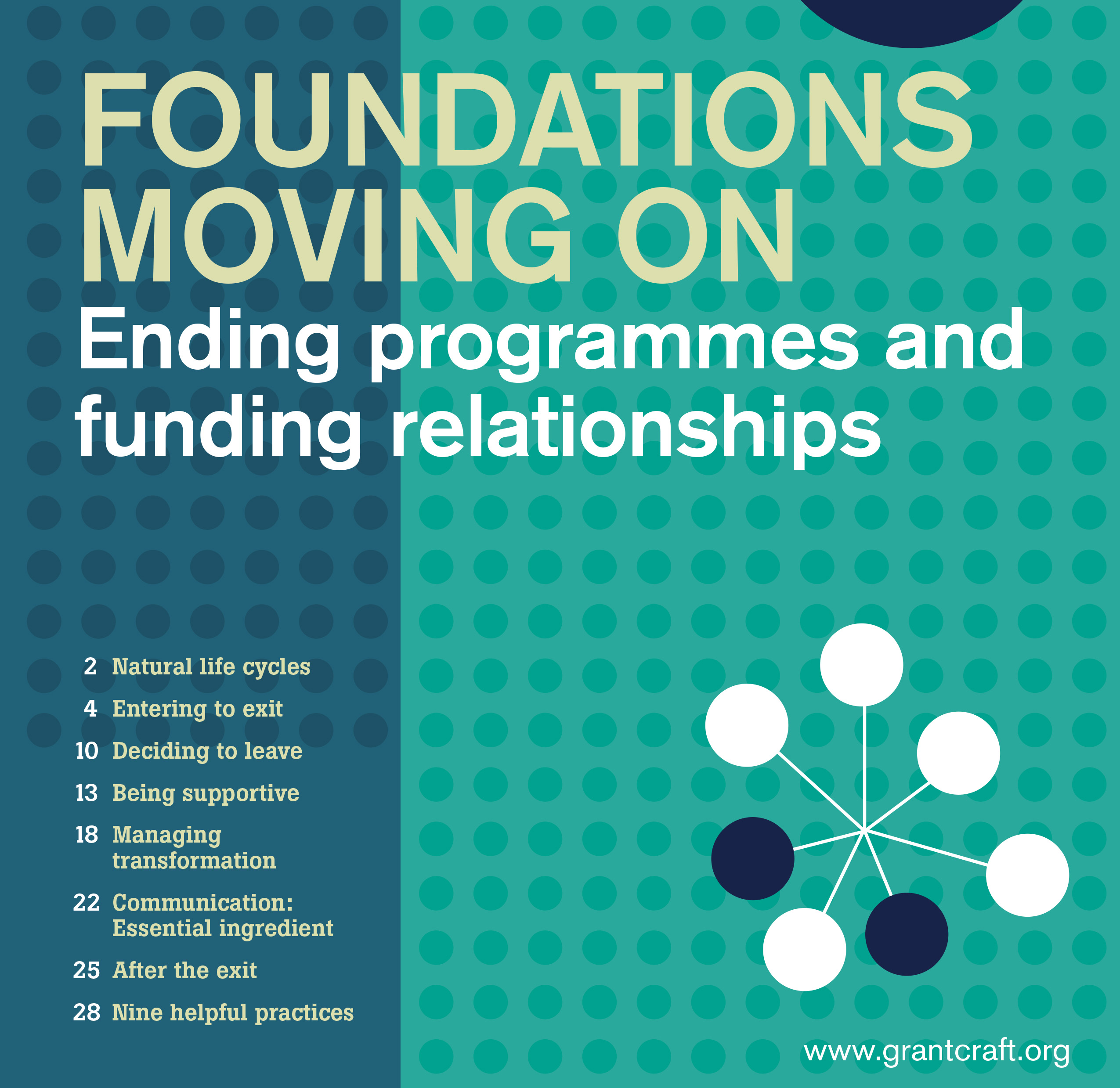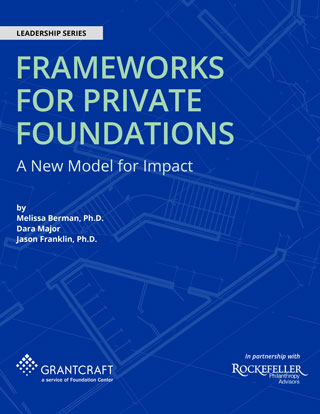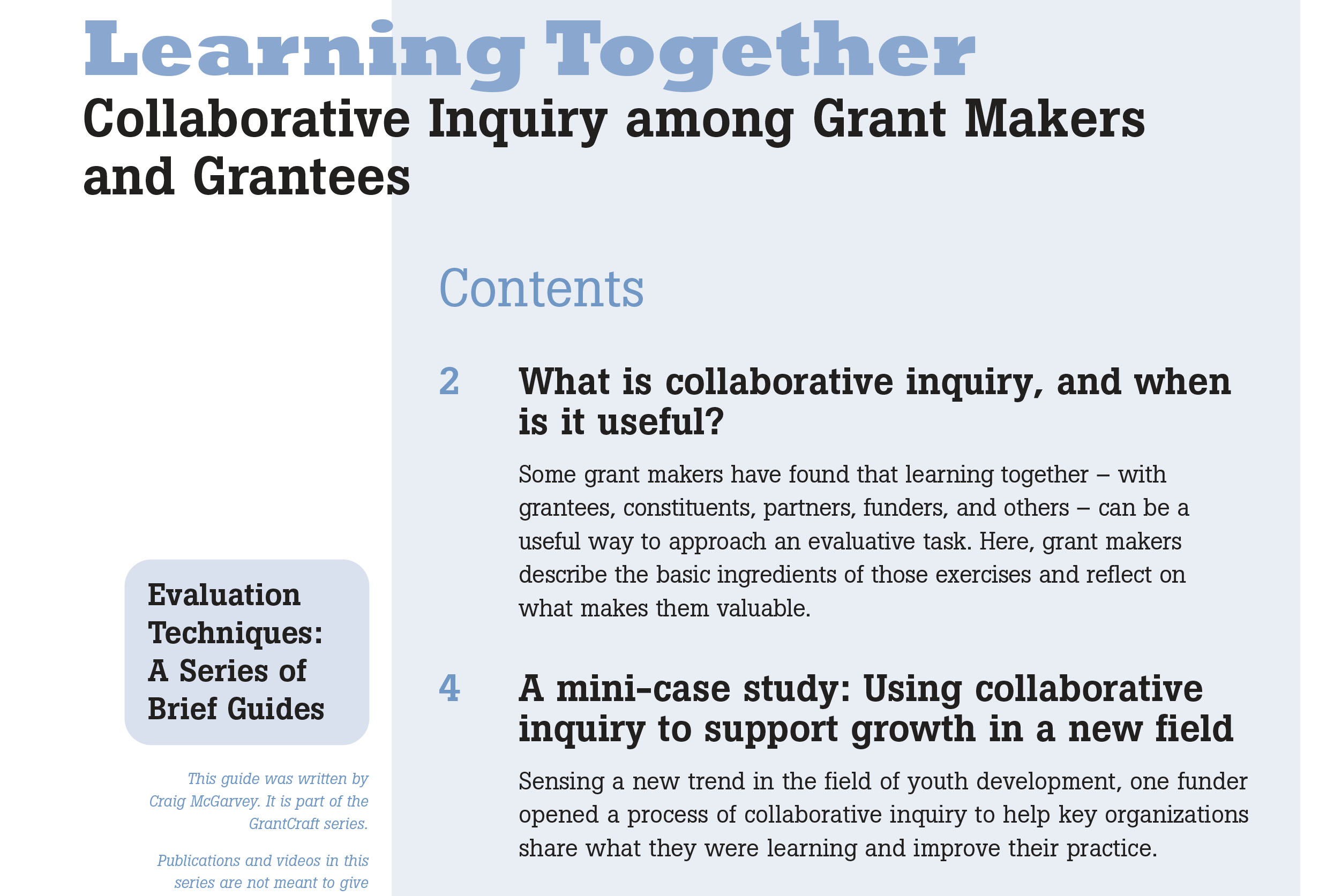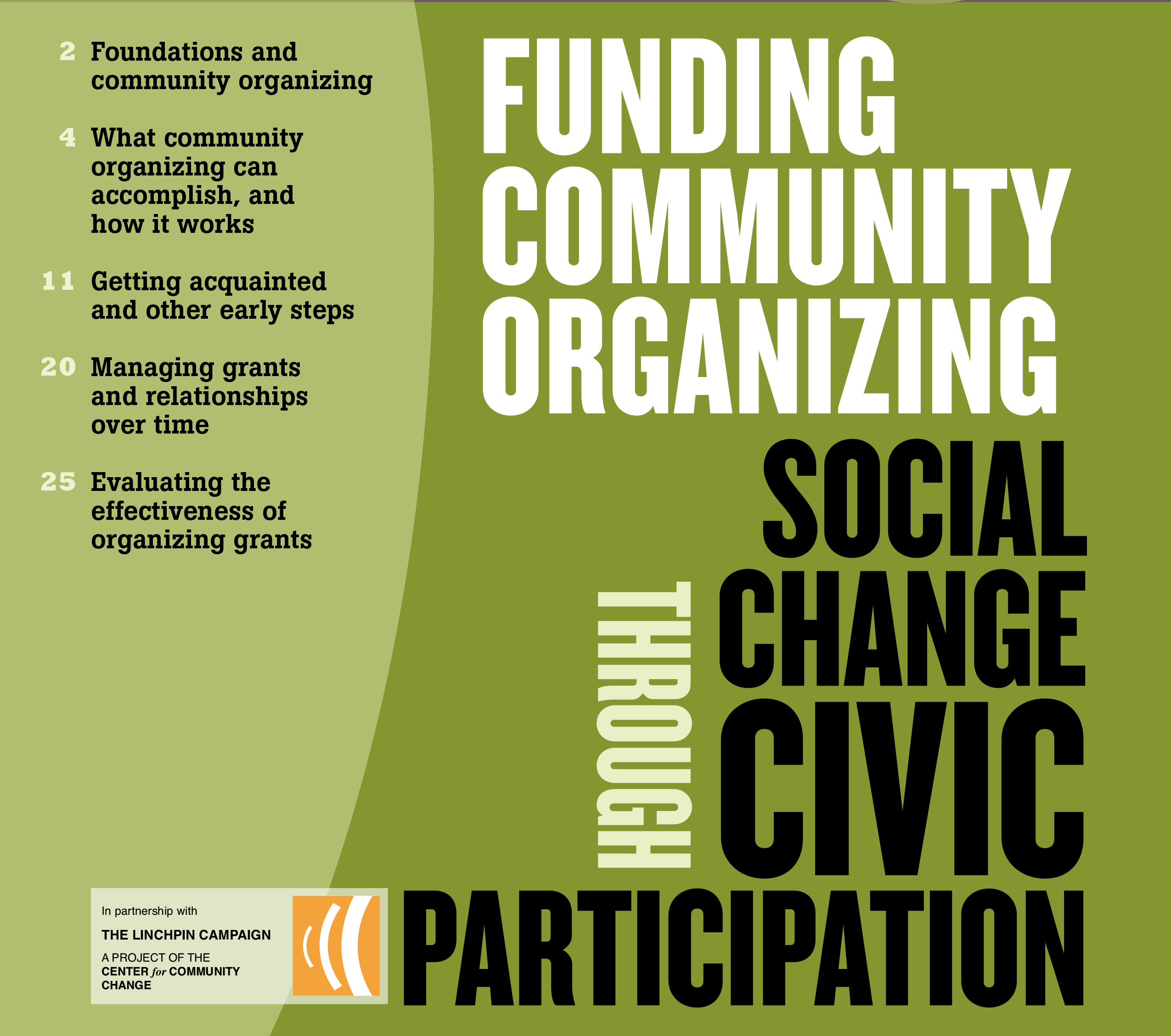The Effective Exit Managing the End of a Funding Relationship
In grantmaking, is there such a thing as the good goodbye? Yes, say contributors to this guide, who have found ways to plan for exits upfront, clarify expectations with grantee organizations, and overcome the tensions that so often arise. Learn how to use the end of a funding relationship to boost a grantee's capacity, find new sources of support, and even multiply the value of the foundation’s investment.
Highlights
- Exit strategies used by four grantmakers
- Learning from spend down foundations
- When you're the one who's exiting
- Breaking the ice with new funders
What's in the Guide?
- Exiting Is Normal: Saying goodbye to grantees is an inescapable part of the grantmaker's role. To do it well, our contributors told us, it's important to think upfront about an exit scenario that advances the aims of the grantee, the foundation, and the larger field. Put the exit on the table from the start, they said, and keep it there as a predictable phase in the funding relationship.
- Communicating Clearly with Grantees: For a grantee, the exit of a funder is always bad news, even when it's planned in advance. A grantmaker can set a positive tone by communicating consistently — over the course of the grant and as the end approaches. When everyone at the foundation sends the same message, that's even better.
- Strengthening Grantees' Organizational Capacity: Grantmakers often find themselves thinking hard about the future of a grantee organization as an exit approaches, especially if the grantee is relatively new, small, or unstable. Here are some ways to help: talk regularly with grantees about their organizational capacity, suggest using consultants for business planning and other services, and provide grants to pay for those services.
- Helping Grantees Find New Funding: Ah, the bottom line. What grantees really want and need is help with fundraising. A matching or challenge grant can work well in the right situation, grantmakers said. Yet even without special funding, there are simple, powerful things you can do to put your grantees in touch with new funding prospects on a regular basis.
- Maximizing the Impact of the Grant: An exit can be an occasion to look back on what was accomplished, distill lessons, and disseminate what was learned. To let grantees do those things, some funders offer special support through transition or tie-off grants. Grantmakers' own efforts to strengthen the field can also extend the value of a foundation's investment.
- Special Cases: When the Exit Isn't Normal: And then there's the exit where thinking upfront just doesn't apply: the exit where something goes seriously wrong or the funder's own situation changes dramatically. These are the cases that test a grantmaker's poise, acumen, and ingenuity.
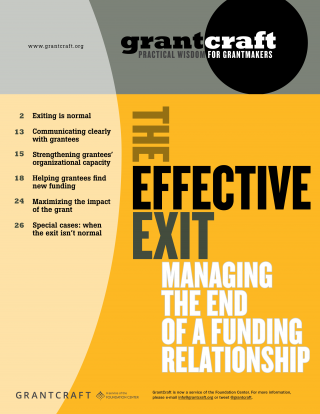
Categories
Content type
-
Link to Funding Community Organizing
Exits Lead to Sharing Wisdom and resources from two spend down foundations
The French American Charitable Trust and the Andrea and Charles Bronfman Philanthropies have both thoughtfully considered how their exits from funding relationships and, eventually, the funder landscape can be useful to other funders. One strategy is to share commissioned reports publicly, so that others can leverage their learnings and wisdom.
Read more -
Link to Funding Community Organizing
What Grantees Wish Grantmakers Knew about Exiting
Transitions take time. If you’ve been a core funder of an organization, it might take a while for the grantee to adjust to the idea that you won’t be around any longer. And, said one grantee, “a budget to help with the transition really helps."
Read more -
Link to Funding Community Organizing
Maximize the Impact of a Grant Continued Partnership
A foundation can sometimes help an exiting grantee simply by continuing to treat it as a partner in ways that don’t entail grants. One foundation has a policy of allowing nonprofits working in its interest areas to use its centrally located facilities for special meetings.
Read more -
Link to Funding Community Organizing
Maximizing the Impact of a Grant Transition Supplements
Some foundations provide special resources to help grantees document and share lessons and accomplishments. At one large foundation, for example, program staff can propose “transition supplements” for grantees within a year of closing out their projects to support communication and dissemination. The foundation awarded roughly 25 such grants annually in the first few years of the program, then studied the projects to establish a “typology” of transition activities that serve the needs of exiting grantees. The types are not always clearly differentiated from one another, a grantmaker noted, but the list has been helpful in enabling program staff to imagine the possibilities.
Read more -
Link to Funding Community Organizing
The Double Whammy When a key co-funder leaves the field
In a “fragile” or difficult-to-fund field, the straitened circumstances of a few key funders can threaten the field as a whole and the stability of certain grantees. A grantmaker working in one such field recalled a period after the September 2001 terrorist attacks in New York when she was seriously worried about the financial future of organizations whose creation and early growth she had supported. To make matters worse, one of the field’s handful of major funders had recently announced that it was closing its doors, and quickly. She and colleagues from four or five other foundations decided to get together to figure out what to do.
Read more -
Link to Funding Community Organizing
Fundraising is a State of Mind
You don’t need to be an expert to help grantees find new funding. These fundraising tips from experienced grant makers are simply habits to cultivate in your own practice:
Read more -
Link to Funding Community Organizing
Helping Grantees Find New Funding Staff Expertise
Under the right circumstances, the expertise of program staff can be a powerful resource for exiting grantees.
Read more -
Link to Funding Community Organizing
Helping Grantees Find New Funding: Matching Grants
Some foundations offer matching or challenge grants to exiting grantees as a way to help them build their funding base.
Read more -
Link to Funding Community Organizing
Helping Grantees Find New Funding: Matchmaking
The trickiest interaction is the one in which a grantmaker tries to make a match between a particular grantee and a particular funder. One foundation CEO characterized the process as “subtle, often indirect, and slow. It requires patience and creative thinking about prospective matches between funders and grantees.”
Read more -
Link to Funding Community Organizing
Healthy Nonprofit Checklist New York Foundation
Program staff use this list to guide conversations with grantees — especially new nonprofits — about their organizational growth and development as the foundation’s exit approaches.
Read more
In grantmaking, is there such a thing as the good goodbye? Yes, say contributors to this guide, who have found ways to plan for exits upfront, clarify expectations with grantee organizations, and overcome the tensions that so often arise. Learn how to use the end of a funding relationship to boost a grantee's capacity, find new sources of support, and even multiply the value of the foundation’s investment.
Highlights
- Exit strategies used by four grantmakers
- Learning from spend down foundations
- When you're the one who's exiting
- Breaking the ice with new funders
What's in the Guide?
- Exiting Is Normal: Saying goodbye to grantees is an inescapable part of the grantmaker's role. To do it well, our contributors told us, it's important to think upfront about an exit scenario that advances the aims of the grantee, the foundation, and the larger field. Put the exit on the table from the start, they said, and keep it there as a predictable phase in the funding relationship.
- Communicating Clearly with Grantees: For a grantee, the exit of a funder is always bad news, even when it's planned in advance. A grantmaker can set a positive tone by communicating consistently — over the course of the grant and as the end approaches. When everyone at the foundation sends the same message, that's even better.
- Strengthening Grantees' Organizational Capacity: Grantmakers often find themselves thinking hard about the future of a grantee organization as an exit approaches, especially if the grantee is relatively new, small, or unstable. Here are some ways to help: talk regularly with grantees about their organizational capacity, suggest using consultants for business planning and other services, and provide grants to pay for those services.
- Helping Grantees Find New Funding: Ah, the bottom line. What grantees really want and need is help with fundraising. A matching or challenge grant can work well in the right situation, grantmakers said. Yet even without special funding, there are simple, powerful things you can do to put your grantees in touch with new funding prospects on a regular basis.
- Maximizing the Impact of the Grant: An exit can be an occasion to look back on what was accomplished, distill lessons, and disseminate what was learned. To let grantees do those things, some funders offer special support through transition or tie-off grants. Grantmakers' own efforts to strengthen the field can also extend the value of a foundation's investment.
- Special Cases: When the Exit Isn't Normal: And then there's the exit where thinking upfront just doesn't apply: the exit where something goes seriously wrong or the funder's own situation changes dramatically. These are the cases that test a grantmaker's poise, acumen, and ingenuity.



